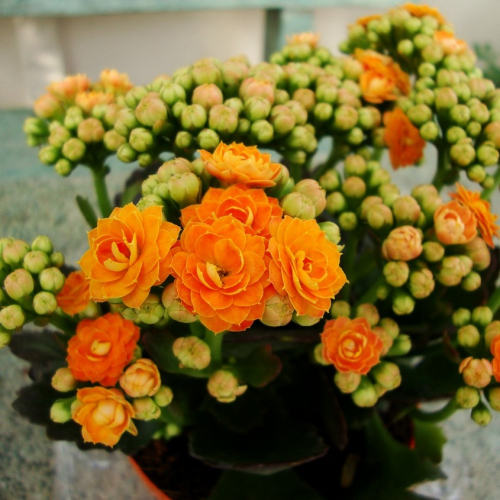Indoor plants Kalanchoe

Description
Special Features of Kalanchoe
Kalanchoe, also written Kalanchoë or Kalanchöe, is a genus of perennial leaf succulents in the family Crassulaceae. It contains over 200 species (herbaceous plants, shrubs, lianas, and epiphytes). They are native to tropical areas of Australia, South America, Africa (including Madagascar), tropical and subtropical Asia (including China, India, Malaysia, the Moluccas, and New Guinea). In addition, botanists sometimes add about 20 species to the genus Kalanchoë from the genus Bryophyllum ("live leaf") of the same family, mainly occurring in Madagascar.
The most common indoor species are dwarf hybrids of Kalanchoë blossfeldiana (up to 30 or even 15 centimetres tall as in varieties Compact Lilliput, Margarethe, and Tom Thumb). They are loved for their long and profuse flowering (profusion achieved and enhanced by pinching). The multi-flowered umbrella-like terminal inflorescences (white and yellow, orange and purple, pink, purple and bright red) containing over 60 flowers are amazing. Some people believe that Kalanchoë can blossom over and over again (that is, the plant will bloom almost all year long), if you add one more element to the care. However, this method is not justified and sounds weird (see below in the "The Secrets to..."). Kalanchoe blossfeldiana has ovate leaves up to 7 centimetres long, dense, smooth, dark green with a reddish border.
Kalanchoë tomentosa, or Panda Plant, growing up to 50 centimetres tall is very different from other plants in the genus. It has a dense rosette of leaves with brown spots on the edges (tips also brown) and thick silver grey hairs (hence an affectionate nickname of Pussy Ears). It does not often bloom indoors.
Kalanchoë daigremontiana, also known as Mother of Thousands, Alligator Plant, or Mexican Hat Plant, is a shrub with fleshy grey green triangular leaves up to 20 centimetres long, sometimes folded along the central vein. In the indentations in phylloclade margins, buds develop and eventually turn into tiny plantlets with threadlike roots, making a very touching sight. After dropping off, they quickly take root (which is why the word "Kalanchoe" is translated from Chinese as "viviparous") and can invade neighbouring pots. The flower colour is purple, classic green, or cream. Indoors, flowering occurs sporadically in the autumn or winter. Kalanchoë daigremontiana can treat abscesses and skin diseases but is not used in the official medicine.
Kalanchoë manginii is known as a "producer" of hybrids. This plant with small leaves and orange bell-shaped flowers on drooping stems is perfect for growing in containers.
In Russia, Kalanchoë pinnata has been long referred to as the "indoor ginseng". In experiments with laboratory animals, scientists found out that its sap helps to heal wounds and burns. For some time now, the pharmaceutical industry produces a drug called Kalanchoe Juice widely used as an external anti-inflammatory agent.
Antibacterial and antiviral qualities of Kalanchoe have lead to a strong belief that this plant cleans the air indoors. There are stories about pests (for example, spider mites) leaving the neighbouring plants.
The Secrets to Successfully Growing Kalanchoe
Kalanchoe prefers bright places. It is often placed in the window and sometimes a reflecting screen is used to increase light intensity. This solution is correct (and the invention is useful), but make sure your plant will not be scorched by direct midday sunlight or get leggy if the plant is not getting enough sun.
Some experts rely on the information that Kalanchoe blooms in response to the length of the day and requires 12-14 dark hours to bloom. They recommend hiding the plant in a closet from 6:00 p.m. to 8:00 a.m. or placing an opaque covering (for example, a cardboard box or dense black PE bag) to make it rebloom. Moreover, the temperature must be lowered to about 16 ° C. They claim that 1-2 months later (or 5-6 weeks, according to some sources), buds will appear.
The information underlying this statement is true but the practical conclusions are wrong. In fact, stimulating the first flowering of Kalanchoe after repotting by using a cover is admissible. However, forcing the plant to rebloom repeatedly throughout the year without a resting period is cruel. The plant will not survive for more than 12 months under this pressure. Consider if you want to boost the death of your plant or enjoy many years of its life?
Water a) moderately; b) after the top soil is dry; c) make sure there are no sharp fluctuations in humidity. In the winter during the resting period from October to February, water sparingly.
Kalanchoe is tolerant to dry air but will do well with a regular misting. Do not mist flowers.
The best temperatures are 20-23 ° C in the summer and 10-15 ° C in the winter.
Normally, Kalanchoe blooms naturally (without stimulation) from late spring to mid-summer. During this period, feed the plant with any compound fertilizer every 1-2 weeks and with cactus fertilizer every month.
Repot Kalanchoe annually (in any case, at least once every two years) in the spring. Use fresh slightly acidic (pH = 5.0-6.0) or neutral (pH = 6.0-7.0) potting soil prepared from loam, leaf mold, and sand at 2:2:1. The new pot size should be only a little larger.
Propagate Kalanchoe by cuttings and seeds ("viviparous" species with pups).
Pruning is not necessary, if you decide to limit the life of the plant to one year. Otherwise:
- Prune the plant after flowering (leaving only a few centimetres of shoot from the ground).
- Move the pot to a dark place and keep the soil dry.
- Four weeks later, bring the plant back to light and place in the window).
Potential Problems
The leaves drop because of too high temperatures in the winter.
Growths resembling cork may form on the leaves and stems in a cool environment with sharp fluctuations in soil moisture and humidity.
High temperatures and soil moisture contribute to mildew. In cold and too humid air, the plant can get grey mold.







 5 349
5 349







